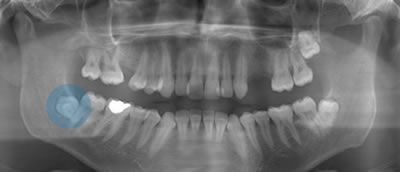We always take care of your smile


In orthodontic treatments, after the presence of impacted teeth is detected, three-dimensional imaging methods may be used to determine the exact position of these teeth.
If your orthodontist decides that the impacted tooth can be incorporated into your dental arch and you agree to a treatment that may take a little longer than usual, you have the chance to use your natural tooth.
In some cases, the position of the impacted tooth may make it very difficult or even impossible to integrate it into the dental arch. In such cases, the impacted tooth may need to be extracted, or if extraction is difficult or risky, it may be left in its current position. In this case, since the tooth will be missing in the dental arch, its place can be compensated with an implant or prosthetic.

Image 1: Impacted tooth seen on panoramic film before orthodontic treatment
The teeth that most frequently remain impacted in the mouth are, in order: third molars (wisdom teeth), upper canines, lower second premolars, and lower canines.
If the position of an impacted wisdom tooth is poor, the solution is usually surgical extraction. Your dentist will guide you regarding the extraction of these teeth. The removal of wisdom teeth does not cause a significant loss in terms of aesthetics or function. However, if the impacted teeth are upper canines or lower second premolars, the situation changes.
Upper canines are among the most important teeth in the mouth. Their roots are longer compared to other teeth, and they are often used in bridge construction in case of missing teeth in the future. Canines are also aesthetically important because upper canines complete your smile and form the corners of the dental arch.
Due to their corner position and long roots, they create a slight prominence in the upper jaw bone. If missing, a depression occurs in this bone area. Especially in cases of unilateral upper canine absence, the missing corner creates a visible asymmetry in the smile, which draws attention and can be visually displeasing.
We always take care of your smile
+90533 302 77 78
Dentamar Oral and Dental Health Polyclinic Services © 2025 | All Rights Reserved. Crow Digital Agency